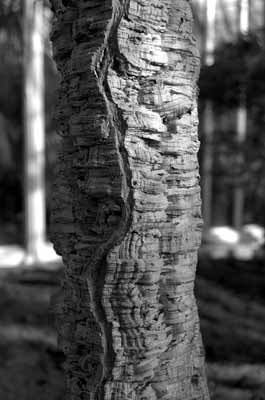Bark Is Better than the Bite
Tree Bark Provides a Creative Way to Add Texture to Landscapes
Plants that live longer than a season or two have lots of strategies for surviving the rigors of changing temperatures and water availability. One of the key components in a woody plant’s defensive system is the outermost layer of the trunk and older stems, what we call bark. It consists mostly of dead cells that are pushed to the outside of the stem as the cambium layer produces new water-conducting cells on the inside, and nutrient-conducting cells outside of this layer. Bark protects the plant from desiccation and makes it more difficult for predators, from insects to larger herbivores, to reach the plant’s juicy insides. But just as with any other feature of plants, diversity is the key to evolutionary success, and lots of different types of bark have arisen. For gardeners, there are some particularly ornamental ones that add just one more dimension to the landscape.

Cork oak (Quercus suber) is probably king in the world of bark. Native to the Mediterranean, these trees produce very thick layers of bark; thick enough to cut off and shape as bottle corks or other useful items. Besides being useful, cork oak bark is also handsome and decorative. Check out some cork oaks planted in the medians of the city parking lot on Anacapa Street, between Cota and Haley.
Bark is stretched as a tree grows, and many barks develop fissures that give the trunk great texture. Many specimens of the she-oak, Allocasuarina, are remarkable for their extremely furrowed chestnut brown bark. Even within a genus of plants, different species may have different types of bark. The bark on swamp mahogany (Eucalyptus robusta) is deeply grooved and pithy, and persists from year to year, while many other eucalyptuses such as E. camaldulensis and E. cladocalyx have thin, peeling bark that sheds each year in patches or long strips. The paperbark trees (Melaleuca quinquenervia and M. styphelioides) have very pale, papery bark that flakes off as the tree grows. Bark can be a distinguishing feature for pines species, too; picture the orangish brown bark of the Italian stone pines (Pinus pinea) on the lower blocks of Anapamu Street.
Several other trees and shrubs have decorative bark. Madrone (Arbutus unedo) bark and strawberry tree (A. unedo ‘Marina’) bark both have dull brown outer layers that peel off to reveal shiny cinnamon brown underlayers. Many manzanitas (Arctostaphylos species) also have very handsome, smooth bark in shades of brown, reddish-brown, and even nearly black. The pale bark of aspens and other poplars and cottonwoods (all in the genus Populus) is certainly one reason these trees get planted in gardens (although their fall color and dancing leaves may be just as well-loved).
If I mention dogwood, most people will imagine clouds of white or pink flowers glowing in the deep shade of the forests in southern states. But there are a couple of species of dogwood that are also popular for their colorful bare winter stems. Although bloodtwig dogwood (Cornus sanguinea) is named to persuade-and its stems are reddish, all right-its cousin red twig dogwood (C. stolonifera) may actually be brighter red. There even is a selection known as yellow twig dogwood (C. stolonifera ‘Flaviramea’). Crape myrtles also are best known for their floral displays, but their pale gray bark peels to reveal smooth trunks and branches in a warm brown, making them instantly recognizable once their patterns have been revealed.
In Southern California, gardeners sometimes rely on the ability to grow flashy flowers in larger-than-life landscapes full of tropical splendor just because they can. But there are other, subtler ways to bring excitement into the landscape. It’s time to look past the forest and peer at the trees (and shrubs) for another element of beauty and texture: bark.
P.S. There’s one more very interesting tree that’s just made for our area. The bark is green (that’s attractive in itself) and covered in stout prickles. These prickles range in size from less that a half inch in diameter to well over one inch, and they are grayish-brown in contrast with the trunk. Formerly known as Chorisia speciosa, it is now included in the genus Ceiba to which the kapok tree belongs. Drive or walk along the 2400 and 2500 blocks of Santa Barbara Street to get the full effect of these tropical giants.



